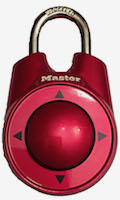Locks
What would an escape room be without locks? The puzzles the players solve culminate in the opening of a box or door. Any interesting escape room is going to have 5-10 locking mechanisms, and padlocks are the easiest type to use.
Chances are, you don’t have quite this many padlocks lying around. Fortunately, you’re not using them to really secure anything value. The locks are more symbolic than anything else. So for less money than it would take to go to a commercial escape room, you can buy enough locks to build your own (or use the makeshift solution at the end).
Digit Locks

Often, it is easiest to create puzzles that make numbers, so most of the locks I use are number combination locks. You will want something where you can set your own code (most digit locks let you do this).
Simple luggage padlocks will do the trick. I have had good luck with these luggage digit padlocks. They are cheap, but they are easy to set a code and ar unambiguous when you dial in the code. As an added bonus, the dials have different colors, which you can work into clues (but keep in mind that the colors are not in a consistent order).
Word Locks
To make things more interesting, it is fun to incorporate code words into the puzzles. For this, you need a padlock that uses letters instead of numbers.
There are multiple such locks available. I have a love-hate relationship with the Master Lock word combination padlock. The construction is solid enough for a puzzle (I’ve seen them used in commercial escape rooms many times), but the stupid thing doesn’t come with enough letter dials to actually form words. (It has 5 dials, but only comes with 4 dials with letters.) To make interesting words, you really have to buy two or more to mix and match dials. But if you are willing to buy 2 (use one for words and one for numbers), they work quite well.
Directional Locks

Master Lock sells a directional lock that has a knob on front that you push up/down/left/right to form a pattern. You can set it to your own combination of movement, but be careful because I managed to jam up (and hence destroy) one of these locks trying to set the pattern.
A directional lock lends a nice change to the code representation, but it tends to be a little tricky to represent directions in a puzzle. I’ve never seen more than one used in any escape room.
Unfortunately, at the time of this writing, Masterlock has discontinued its production of directional padlocks, and so far no other company is producing any replacements. If you cannot get a hold of a physical directional lock consider this alternative approach.
Key Locks

You can also use locks that open with a key. Key locks are available in just about any size you need.
You may find that you don’t use key locks as much as you would expect. There is not a lot of point in putting keys in boxes, since you have just solved a puzzle to remove the lock for the box the key is in. So keys are typically used in situations where they are hidden. Another situation might be that the physical constraints of a puzzle require a container too small for items it reveals, so you provide a key to the “real” box.
Paper Locks
Honestly, you don’t need physical locks. You could just put a note on a container or door that says do not open until you give the game master the correct code.
But there is something visceral about using a physical lock. The anticipation as the dials click and the cha-chunk when the lock finally opens. I think that adds enough value to justify using the physical locks.